Villains in Ukiyo-e PARTⅡ
[2nd Term] June 30th-July 29th
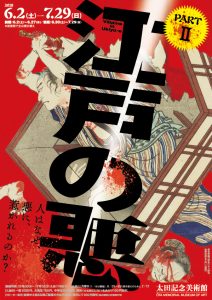
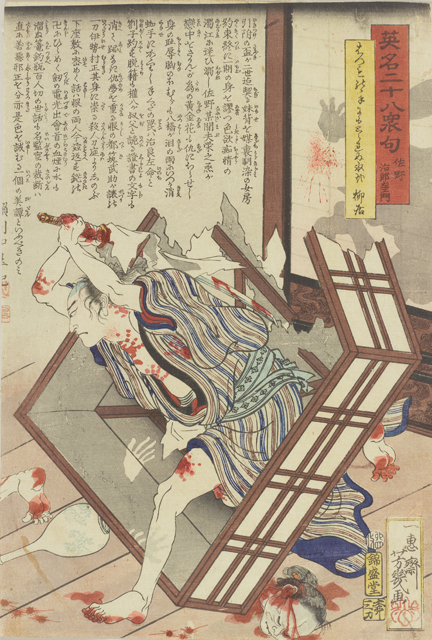
名所江戸百景 隅田川水神の森真崎(前期展示)
Why are we attracted by “evil”?
In TV dramas, movies and novels, villainous roles are often depicted as more attractive than the protagonist roles. The people of Edo also seem to have been aware of the unfathomable attraction of “evil”. For example, when a notorious thief was caught and dragged around the streets, it was filled with people who came to catch a glimpse of the legendary evil man. Big incidents such as Akō Incident in the Genroku period were made into kabuki plays immediately, and Kira Kōzukenosuke, considered to be the villain of the incident, established his position as an evil figure. At the end of the Edo Period, a genre of plays called “Shiranami mono” in which many thieves appeared was popular, and the thieves and scoundrels in these plays were adored. Whether it was in reality or in fiction, people in those days were curious about the charm of “evil”, and were sometimes intoxicated by it.
This exhibition is a revival of one of our most popular exhibitions, “Villains in Ukiyo-e” held in 2015, this time featuring more ukiyo-e that depicts various “villains”. Thieves such as Nezumikozō Jirokichi, chivalrous men such as Banzuiin Chōbei, malicious authorities, evil women and wicked sorcerers, and other villainous figures in Edo from both reality and fiction, are brought to you again in Ota Memorial Museum of Art.
I From thieves, chivalrous men, masterless samurai to villainous authorities, evil women and wicked sorcerers – “villains” in Edo reunited.
Great thieves such as Ishikawa Goemon, chivalrous men such as Karigane Gonin Otoko, Ro-nin (masterless samurai) such as Ono Sadakurō, depraved priests such as Hokkaibō, malicious authorities such as Fujiwara-no Tokihira, evil women such as Dote-no Oroku, and wicked sorcerers such as Nikki danjō. In the Edo period, outlaws and villains grew popular, and were adapted to plays and stories with various dramatization. From those who existed in reality, to those who were created in fiction, “villains” in Edo is brought to you again in Ota Memorial Museum of Art.
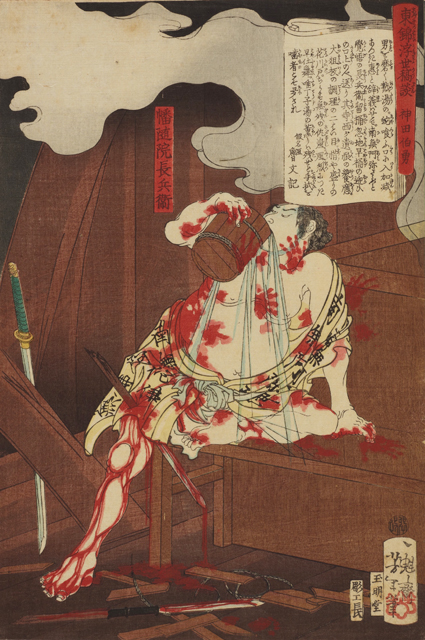
Tsukioka Yoshitoshi : Rough Tales of the Floating World Told on Eastern Brocades : Banzuiin Chōbei Murdered in the Bathroom (2nd term)
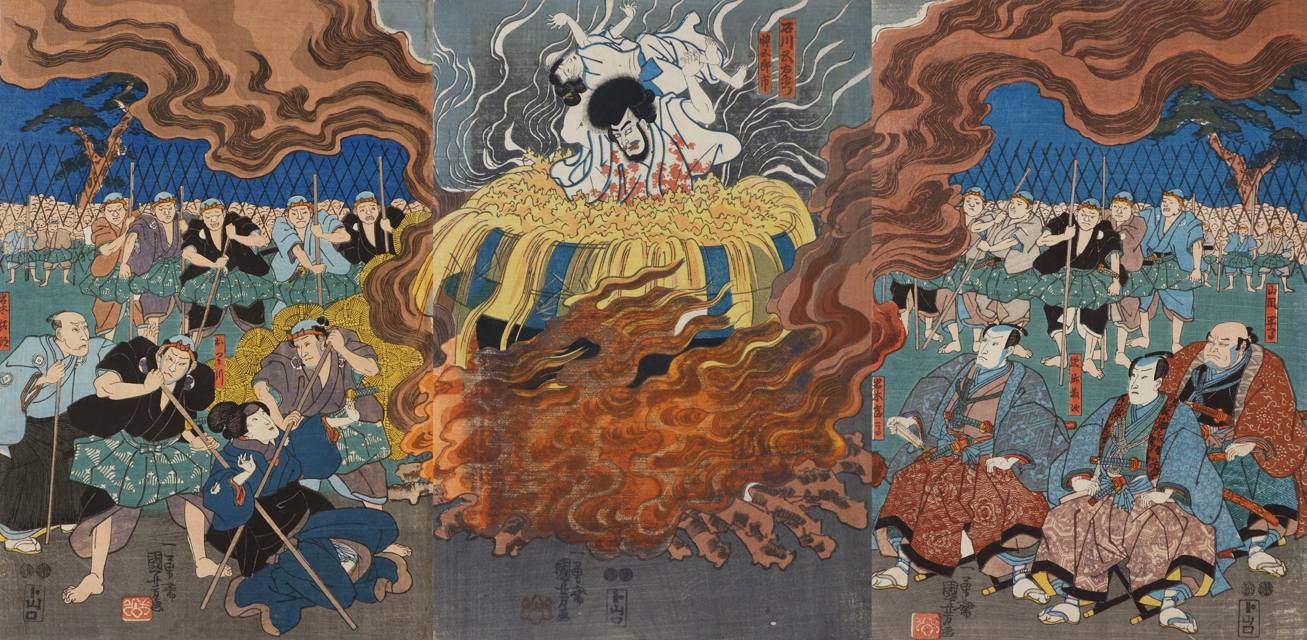
Utagawa Kuniyoshi : Kabuki Play “Kinoshita Soga Megumi no Masagoji” (2nd term)
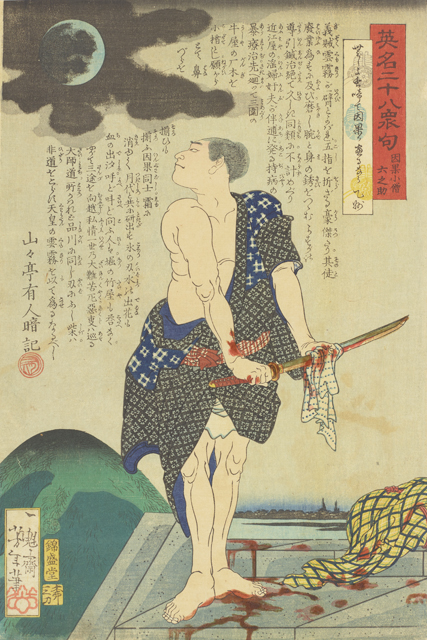
Tsukioka Yoshitoshi : Eimei Nijūhasshūku (Twenty-eight Famous Murders with Verse) : Ingakozō Rokunosuke (1st term)
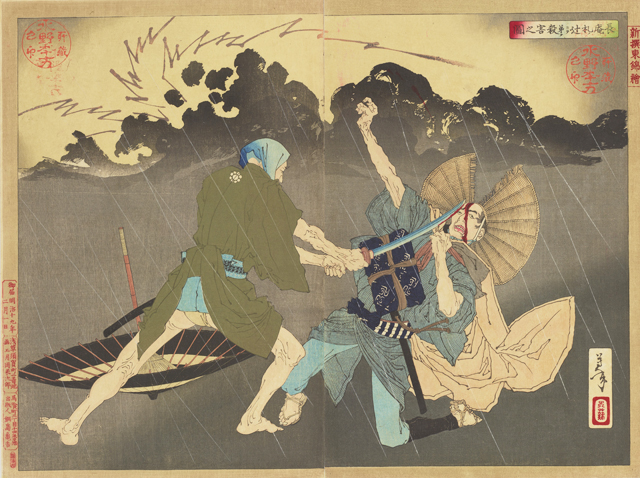
Tsukioka Yoshitoshi : New Selection of Eastern Brocade Pictures : Chōan Killing His Younger Brother at Fudanotsuji (1st term)
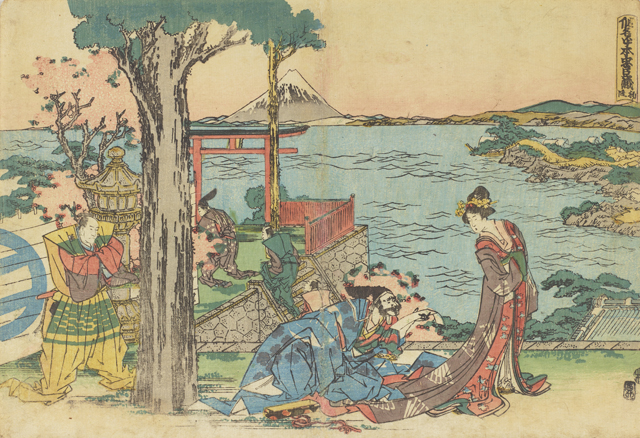
Katsushika Hokusai : Kabuki Play “Kanadehon Chūshingura : Act 1” (1st term)
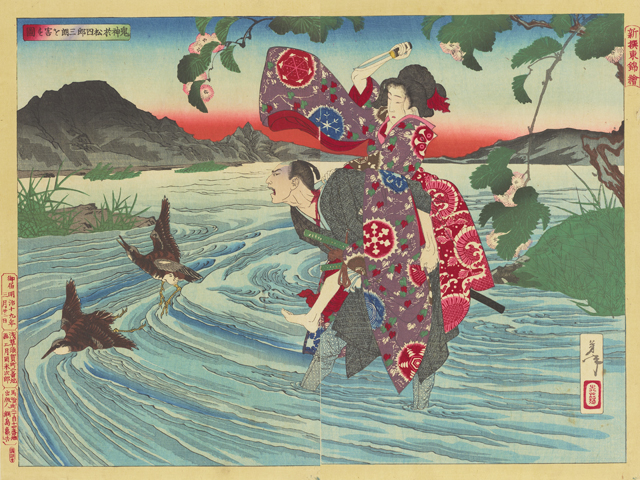
Tsukioka Yoshitoshi : Shinsen Azuma Nishiki-e (New Selection of Eastern Brocade Pictures): Kijin Omatsu Killing Shirosaburō (2nd term)
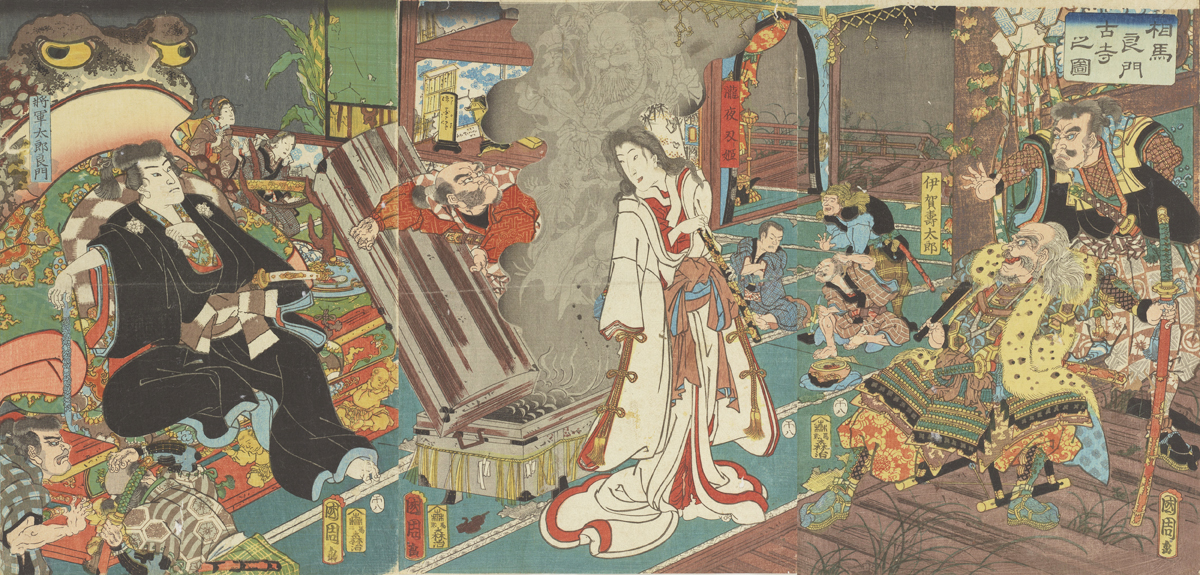
Toyohara Kunichika : Sōma Yoshikado and Takiyasha-hime at an Old Temple (2nd term)
Ⅱ Love and evil
Soapy-opera love affairs were a preferred subject among kabuki plays. “Tōkaidō Yotsuya kaidan”, a famous ghost story by Tsuruya Nanboku Ⅳ, focuses on Tamiya Iemon and his wife Oiwa, and the evil caused by the distorted love of man and woman. The play is based on a true story about Yaoya Oshichi, who commited arson to meet her lover Kichisaburō. The play soon became popular, and many kabuki plays were created and performed. Interestingly, a depraved priest Seigen, in the play “Seigen and Princess Sakura”, who was obsessed with Princess Sakura even after his death, can be considered the first stalker in Japan.
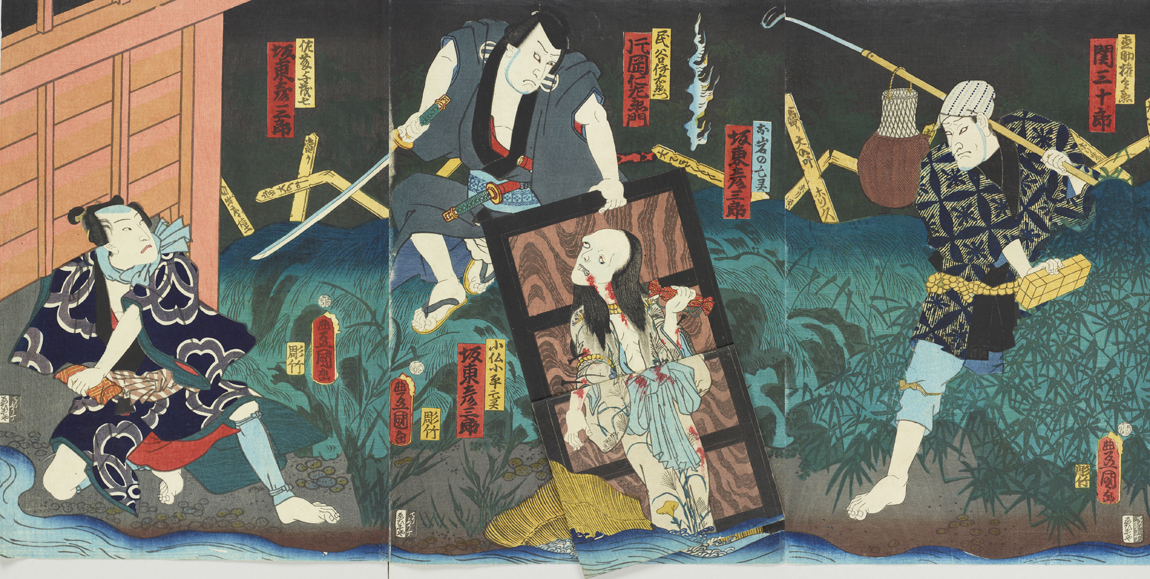
Utagawa Kunisada (Toyokuni Ⅲ) : Kabuki Play “Tōkaidō Yotsuya Kaidan” (2nd term)
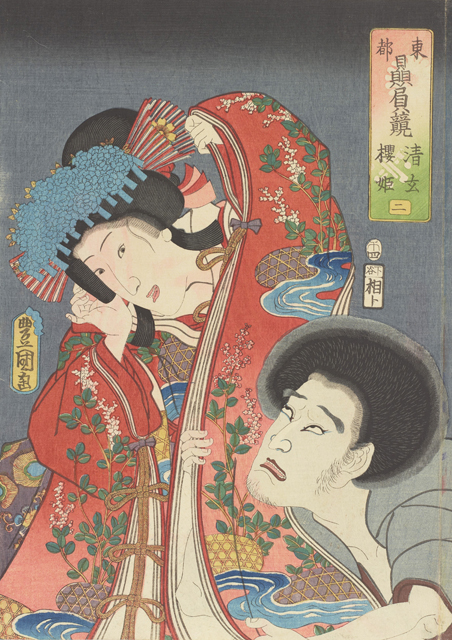
Utagawa Kunisada (Toyokuni Ⅲ) : Tōto Hiiki Kurabe : Seigen and Sakura-hime (1st term)
Ⅲ Between good and evil
The boundary between “good” and “evil” is quite ambiguous. In kabuki plays and Japanese narrative chants, there are stories in which a good person like Sanojirō Zaemon cannot stand the terrible insults he receives and kills many people. On the other hand, there are other stories about a villain like Igamino Gonta in the kabuki play “Yoshitsune Senbon Zakura (Yoshitsune and the Thousand Cherry Trees)”, who performs a good deed before he dies. This attractive subject of people moving between good and evil must have grabbed the interest of people back then.

Ochiai Yoshiiku : Eimei Nijūhasshūku (Twenty-eight Famous Murders with Verse) : Sano Jirōzaemon (1st term)
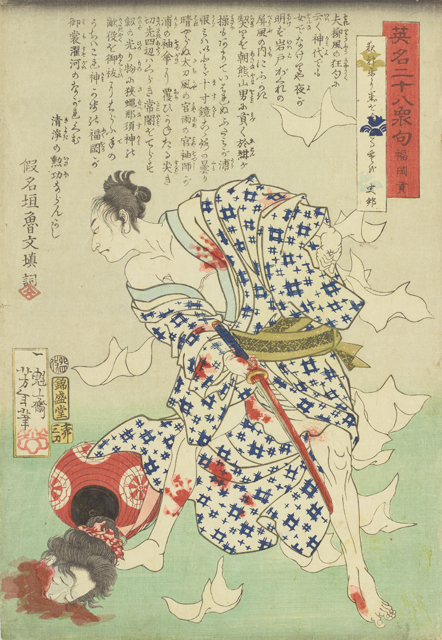
Tsukioka Yoshitoshi : Eimei Nijūhasshūku (Twenty-eight Famous Murders with Verse) : Fukuoka Mitsugi (2nd term)
Admission
| Adult | 1000 yen |
|---|---|
| University and High school students | 700 yen |
| Junior High School Students and below | Free |
Calendar
Closed
-
2018 June
SUN MON TUE WED THU FRI SAT 1 2 3 4 5 6 7 8 9 10 11 12 13 14 15 16 17 18 19 20 21 22 23 24 25 26 27 28 29 30
-
2018 July
SUN MON TUE WED THU FRI SAT 1 2 3 4 5 6 7 8 9 10 11 12 13 14 15 16 17 18 19 20 21 22 23 24 25 26 27 28 29 30 31
